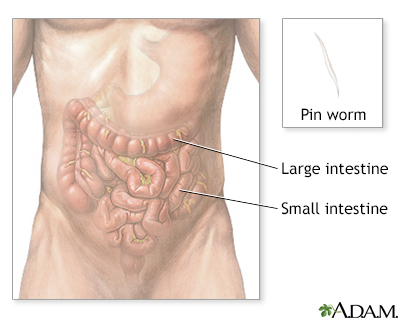Pinworm test
Oxyuriasis test; Enterobiasis test; Tape test
A pinworm test is a method used to identify a pinworm infection. Pinworms are small, thin worms that commonly infect young children, although anyone can be infected.
Images



I Would Like to Learn About:
How the Test is Performed
When a person has a pinworm infection, adult pinworms live in the intestine and colon. At night, the female adult worms deposit their eggs outside the rectum near the anal area.
One way to detect pinworms is to shine a flashlight on the anal area. The worms are tiny, white, and threadlike. If none are seen, check for 2 or 3 additional nights.
The best way to diagnose this infection is to do a tape test. The best time to do this is in the morning before bathing, because pinworms lay their eggs at night.
Steps for the test are:
- Firmly press the sticky side of a 1-inch (2.5 centimeters) strip of cellophane tape over the anal area for a few seconds. The eggs stick to the tape.
- The tape is then transferred to a glass slide, sticky side down. Put the piece of tape in a plastic bag and seal the bag.
- Wash your hands well.
- Take the bag to your health care provider. The provider will check the tape to see if there are eggs.
The tape test may need to be done on 3 separate days to improve the chances of detecting the eggs.
You may be given a special pinworm test kit. If so, follow instructions on how to use it.
How to Prepare for the Test
No special preparation is necessary.
How the Test will Feel
The skin around the anus may have minor irritation from the tape.
Why the Test is Performed
This test is performed to check for pinworms, which can cause itching in the anal area.
What Abnormal Results Mean
If adult pinworms or eggs are found, the person has a pinworm infection. Usually, all household members need to be treated with medicine. This is because pinworms are easily passed back and forth within a household.
Risks
There are no risks with this test.
Related Information
PinwormsItching
References
Dent AE, Kazura JW. Enterobiasis (Enterobius vermicularis). In: Kliegman RM, St. Geme JW, Blum NJ, Shah SS, Tasker RC, Wilson KM, eds. Nelson Textbook of Pediatrics. 21st ed. Philadelphia, PA: Elsevier; 2020:chap 320.
Mejia R, Weatherhead J, Hotez PJ. Intestinal nematodes (roundworms). In: Bennett JE, Dolin R, Blaser MJ, eds. Mandell, Douglas, and Bennett's Principles and Practice of Infectious Diseases. 9th ed. Philadelphia, PA: Elsevier; 2020:chap 286.
BACK TO TOPReview Date: 9/10/2022
Reviewed By: Jatin M. Vyas, MD, PhD, Associate Professor in Medicine, Harvard Medical School; Associate in Medicine, Division of Infectious Disease, Department of Medicine, Massachusetts General Hospital, Boston, MA. Also reviewed by David C. Dugdale, MD, Medical Director, Brenda Conaway, Editorial Director, and the A.D.A.M. Editorial team.

Health Content Provider
06/01/2025
|
A.D.A.M., Inc. is accredited by URAC, for Health Content Provider (www.urac.org). URAC's accreditation program is an independent audit to verify that A.D.A.M. follows rigorous standards of quality and accountability. A.D.A.M. is among the first to achieve this important distinction for online health information and services. Learn more about A.D.A.M.'s editorial policy, editorial process and privacy policy. A.D.A.M. is also a founding member of Hi-Ethics. This site complied with the HONcode standard for trustworthy health information from 1995 to 2022, after which HON (Health On the Net, a not-for-profit organization that promoted transparent and reliable health information online) was discontinued. |
The information provided herein should not be used during any medical emergency or for the diagnosis or treatment of any medical condition. A licensed medical professional should be consulted for diagnosis and treatment of any and all medical conditions. Links to other sites are provided for information only -- they do not constitute endorsements of those other sites. © 1997- 2024 A.D.A.M., a business unit of Ebix, Inc. Any duplication or distribution of the information contained herein is strictly prohibited.
